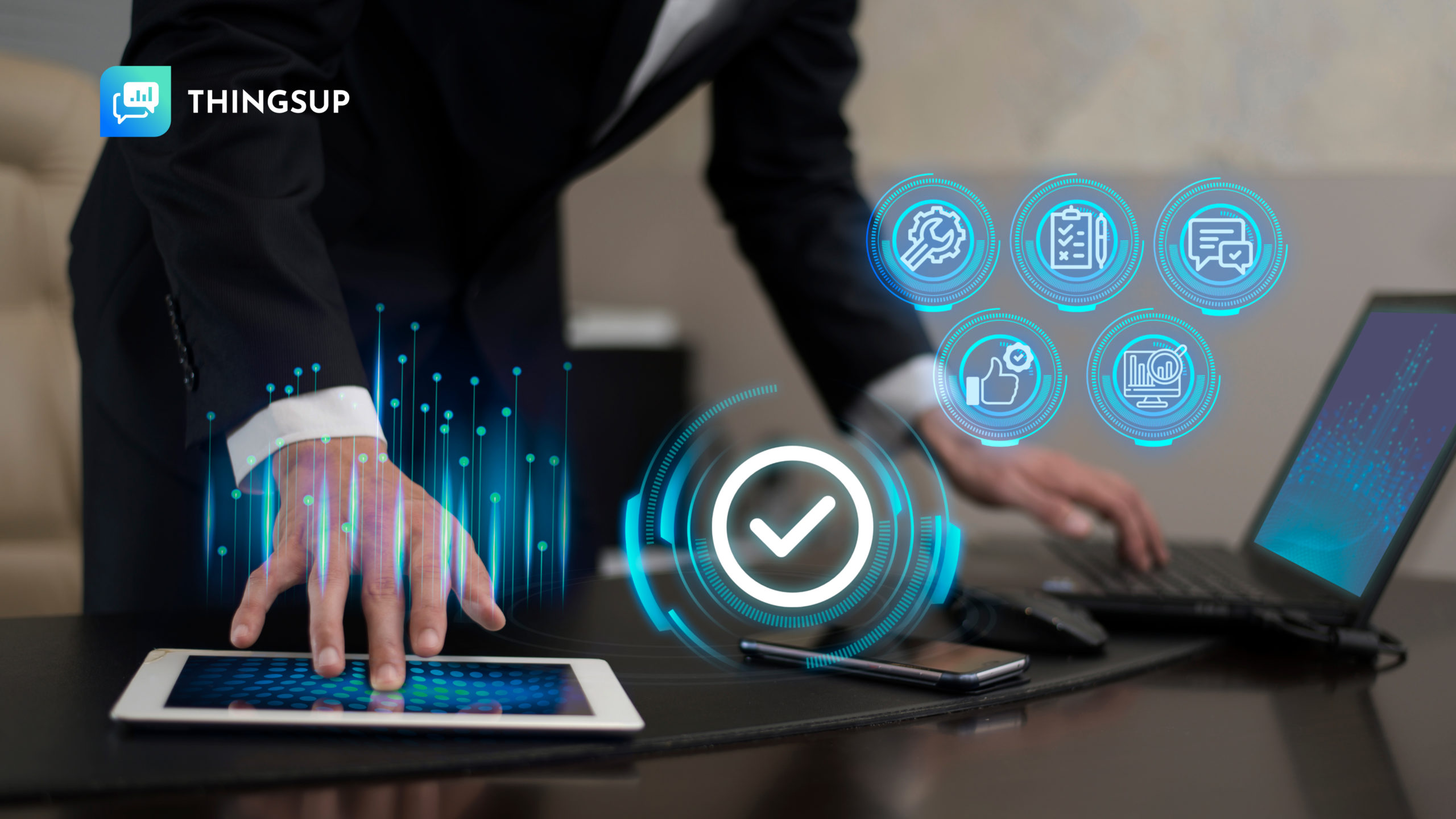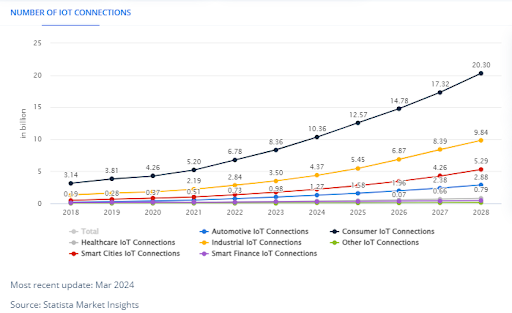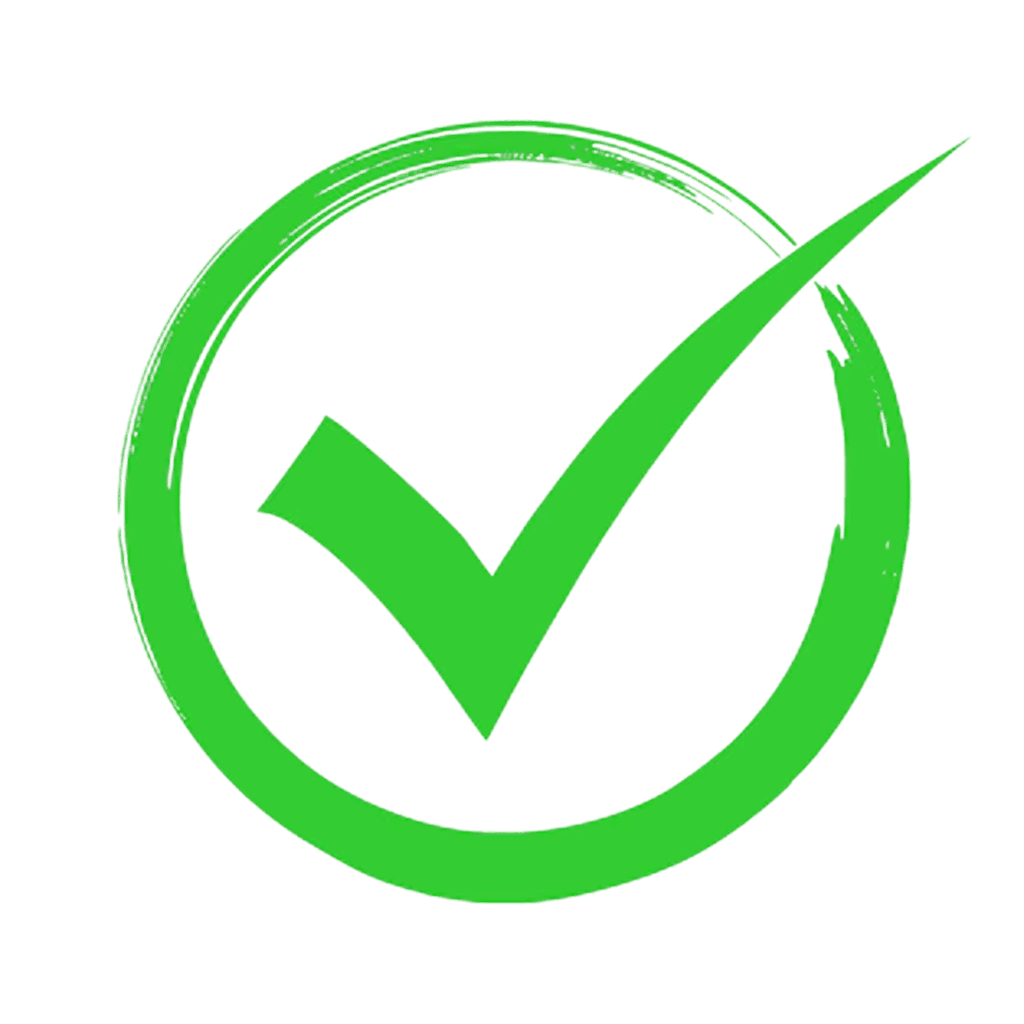According to a report, the current IoT devices have crossed the 10 billion ( in 2019) mark and have reached 18.8 billion. And it is expected that this data will double by 2030 and cross the mark of around 40 billion.
In the years to come, the IoT market is expected to grow at a rate of 10.49% per year (CAGR 2024–2029), reaching a huge US$1,560.00bn in size by 2029.
Here is the report by Statista showing the increasing number of connected IoT devices (based on industries)
This data shows that the use of IoT is increasing day by day. Especially if enterprises want to develop and compete in the international market, they need IoT platforms the most.
However, finding and using an IoT monitoring platform is quite an easy task. However, finding the right IoT platform for the right project is very complicated.
There are 100s of vendors in the market that claim to be the best. However, you will have to do a lot of research to choose the right IoT device management platform per your business requirements.
Today, in this blog, we will talk about those factors by following them so that you can easily choose the right IoT device management platform and make your business future-proof.
So, let’s dive right in..!!
Why Does Choosing the Right IoT Connectivity Management Platform Matter?
The growth of IoT is gaining momentum. As we have just seen in the Statista report, consumer IoT connections will reach 20 billion by 2028. Given its rapid expansion, there seems to be a growing need for businesses to manage various devices, from sensors and cameras to vehicles and industrial machinery.
The IoT device management platform is at the core of managing this complex network. These platforms serve as the backbone of businesses’ IoT infrastructure.
They facilitate device communication, guarantee a stable connection, and supervise data streams.
Having the right IoT platform can improve:
Operational Efficiency: They can smartly automate device management tasks such as provisioning, firmware updates, and diagnostics.
Security: It protects you from cyber threats by providing secure communication channels. Besides, they encrypt data and user authentication to prevent unauthorized access.
Scalability: They add more power to businesses by enabling them to add new devices. Even businesses can add new features as per their needs using these devices.
Cost Management: They aid businesses by optimizing operational costs and balancing their subscription fees, data transmission costs, and device connectivity.
What Are the Key Factors to Consider When Selecting an IoT Device Management Platform?
Security
Cyberattacks often target IoT devices, so security should be the first factor you should consider when choosing an IoT platform. These security risks include data breaches, unauthorized device access, and network vulnerabilities.
Key Security Features to Look For in an IoT Device:
Data Encryption from beginning to end
Data should be encrypted at all stages, whether sending or storing. A common way to keep data safe while it’s being sent is with TLS (Transport Layer Security).
Authentication for Users and Devices
It makes sure that only authorized people and devices can connect to your IoT network with multi-factor authentication (MFA) and secure device provisioning protocols like X.509 certificates.
Continuous Firmware Updates
To stop data vulnerabilities, it’s very important for an IoT platform to be able to send secure over-the-air (OTA) firmware updates. In this way, devices always have the most up-to-date security patches.
Regulations
Regulations like GDPR, HIPAA, or ISO/IEC 27001 may need to be followed if you work in a certain industry. Check to see if the platform meets these requirements.
Scalability
If you want to future-proof your IoT deployment, you must focus on the scalability of the IoT platform. No matter whether you are currently managing ten devices or might have plans to manage ten thousand devices in the near future, your platform should always make you ready to expand without experiencing any disruptions in service or a decline in performance.
Key Scalability Considerations:
Cloud-based Solutions
A few IoT cloud platform, such as AWS IoT Core or Google Cloud IoT Core, offer elastic scalability. It means they can automatically adapt as per the demand fluctuations, whether you’re scaling up or down.
Being able to scale horizontally or vertically
If your IoT device is horizontally scalable, you can add more devices in more places. If it is vertically scalable, you can make existing devices and services more powerful. So, while choosing the IoT platform, both should be supported by your platform, especially if you’re working with IoT deployments that span borders.
Example: Amazon’s AWS IoT Core is known for supporting thousands of devices with very little latency, making it reliable even at large scales.
Connectivity Options
The types of connections you can use will depend on the tasks you need to do, where your devices are located, and how much bandwidth you need. There are pros and cons to each type of connectivity technology.
Common Connectivity Options Include:
4G/5G Cellular Networks
Best for mobile phones and other remote devices that need to send data quickly over long distances.
Wi-Fi
Suitable for IoT devices operating in homes, offices, or urban environments where high-speed internet is available.
LPWAN (Low-Power Wide-Area Networks)
This is an ideal solution for IoT applications requiring low power consumption and long-range communication, such as smart metering, agricultural applications, or industrial applications.
Satellite
Useful for locations that are geographically isolated and need access to other connectivity options.
| Connectivity Technology | Best For | Range | Power Consumption | Cost |
| 4G/5G | Mobile devices, real-time data | High | Moderate | High |
| Wi-Fi | Stationary devices, urban areas | Medium | High | Moderate |
| LoRaWAN | Long-range, low-power applications | Very High | Very Low | Low |
| NB-IoT | Industrial sensors, smart cities | High | Very Low | Moderate |
| Satellite | Remote, isolated locations | Global | High | Very High |
Device Management Capabilities
For any IoT deployment to work, devices must be managed well. The platform should make it easier to set up new devices, check on their health, deploy over-the-air (OTA) updates, and fix problems.
Key Features for Effective Device Management:
Device Provisioning
Device Provisioning means adding devices to the network automatically and securely. Always go with the platforms that let you provision many devices simultaneously (you never know when this feature will be needed). This will make adding or pairing new devices easier and faster.
Remote Monitoring
Your IoT platform should have a central dashboard that shows the status of devices, performance metrics, and diagnostic data in real-time.
Automated Firmware Updates
The ability to roll out updates remotely, also known as over-the-air (OTA) updates, enables you to ensure that your devices are secure and running the most recent firmware without the need for any manual intervention.
Diagnostics and Troubleshooting
Platforms must provide complete diagnostic tools to identify problems in real-time. This will enable you to troubleshoot issues before they become more severe.
Integration with Other Systems
IoT platforms rarely exist in isolation. Additional systems, such as cloud storage, analytics platforms, corporate software (ERP, CRM), and edge computing infrastructure, should be able to integrate with the platform without any issues.
Key Integration Considerations:
API Support
To ensure a smooth interaction of the IoT platform with apps developed by third parties, check that the platform has either RESTful or MQTT APIs.
Cloud Compatibility
IoT device management platforms must interact with popular cloud services like Amazon Web Services (AWS), Microsoft Azure, and Google Cloud to facilitate data’s smooth storage, processing, and presentation.
Edge Computing
In some situations, it may be necessary to handle data closer to where it is created (at the edge). Ensure that the platform supports edge computing, which cuts down the delays and lets you make decisions in real time.
Cost Efficiency
Cost is very important, especially for companies that are setting up big IoT networks. It have a wide range of IoT platform price models, so as a business owner, you can carefully compare them based on how you plan to use them.
Cost Components to Consider:
Platform Subscription Fees
These are often charged on a per-device or per-data-usage basis.
Data Transmission Costs
Data transmission costs can be increased depending on your technology (e.g., cellular, Wi-Fi, LoRa). Along with the technology, transmitting a large amount of data would add to the transmission cost.
Maintenance Costs
Consider the cost of ongoing platform maintenance, such as software updates, hardware upgrades, and security patches.
Support and Customer Service
Take into consideration the type of support that the platform provides. Whether it’s to resolve technical issues, provide assistance with onboarding, or answer general questions, having access to dependable customer support can help save time and prevent costly downtime.
Support Features to Look For:
24/7 Availability
Many IoT systems run continuously, so you must ensure they provide round-the-clock support, as users may need assistance anytime.
Dedicated Account Managers
Some platforms offer a dedicated account manager responsible for providing personalized support and reducing needed it takes to resolve issues.
Community Forums and Documentation
A strong developer community and thorough documentation can also be very helpful when troubleshooting and sharing knowledge.
Detailed Comparison of Top IoT Connectivity Platforms
| IoT Platform | Device Connectivity | Data Management | Scalability | Security Features | Pricing Model |
| AWS IoT Core | Supports MQTT, HTTP, WebSockets; integrates with Amazon’s ecosystem (Alexa, S3, Lambda, etc.) | Advanced real-time analytics, integrates with AWS services | Highly scalable, enterprise-grade | TLS encryption, identity and access management | Pay-as-you-go |
| Azure IoT Hub | Supports AMQP, MQTT, HTTP; integrates with Azure cloud services (Machine Learning, Power BI, etc.) | Enables data processing via Azure Stream Analytics, Azure Functions | Enterprise-scale solutions, edge computing capabilities | Full identity-based security with X.509 certificates | Flexible subscription and consumption-based pricing |
| Google Cloud IoT | Supports MQTT, HTTP; integrates with Google’s Cloud Platform (BigQuery, DataFlow, etc.) | Real-time data insights, machine learning integration | Automatic scalability, edge computing capabilities | Two-factor authentication, TLS encryption | Pay-as-you-go |
| Thingsup | Supports MQTT, HTTP; integrates with industry-standard hardware (ESP8266, Raspberry Pi, GSM/NB-IoT, etc.) | Real-time data analytics, cloud integration with AWS, rules engine for data validation and transformation | Enterprise-grade scalability with microservices architecture | End-to-end encryption, authentication mechanisms, and intrusion detection | Pay-as-you-go, starting at 1 USD |
| IBM Watson IoT | Supports MQTT, HTTP; integrates with IBM Watson (AI, cognitive services) | Advanced analytics with Watson AI, integrates with IBM’s data services | Scalable for enterprise solutions, designed for industrial IoT | Data encryption, device identity verification, anomaly detection | Flexible pricing based on device connections |
| Cisco Kinetic | Supports multiple protocols, especially focused on industrial IoT | Data processing and orchestration across the edge and cloud environments | Highly scalable for industrial environments | Full enterprise-grade security features (encryption, access control) | Subscription-based pricing model |
Thingsup: A Powerful Enterprise-Grade IoT Platform
So, if you are searching for the right IoT platform that fits your business, Thingsup is a great option. It is an enterprise-grade IoT platform with real-time monitoring, efficient device management, and scalable solutions that meet your business needs.
Key Features of Thingsup IoT Platform:
Real-Time Monitoring
Thingsup lets companies monitor connected devices in real time, ensuring they work at their best. It also helps fix problems before they happen.
Efficient Device Management
Thingsup makes it easier to set up, update, and control multiple IoT devices from a single interface by optimizing the IoT device management system.
Data collection and Visualization
Thingsup makes it easy to collect data and gives you dashboards to see insights in the most important ways to your business. This lets you make quick decisions based on data that you can use.
Work with Scalable IoT Applications
The platform supports scalable IoT apps, making it perfect for companies that want to expand their IoT operations without lowering the quality of their work.
Conclusion
You must take special care of many things while selecting the best IoT device management platform. The most important are scalability, security, connectivity options, device management capabilities, and cost.
Although there are many platforms available in the market, you have to first look at the requirements of your business; then, you can choose the IoT platform that best suits your needs.
Just go through the important factors, and you’ll be able to make a decision that will help your IoT deployment succeed in the long run.







